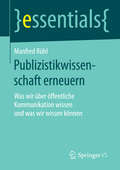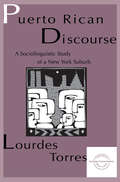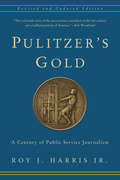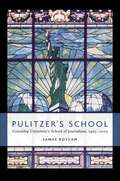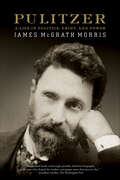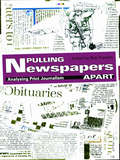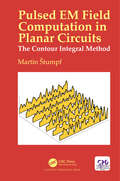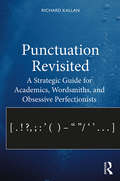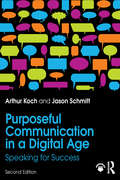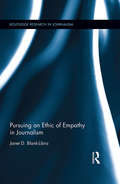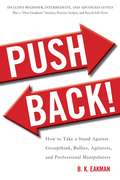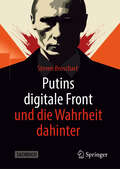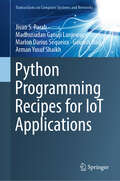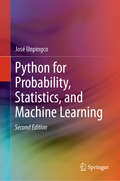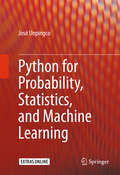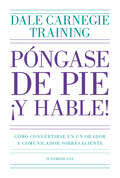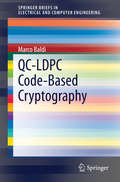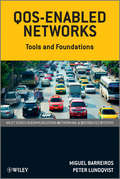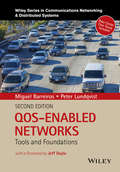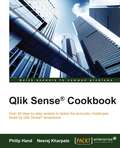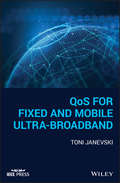- Table View
- List View
Publizistikwissenschaft erneuern: Was wir über öffentliche Kommunikation wissen und was wir wissen können (essentials)
by Manfred RühlManfred Rühl rekonstruiert öffentliche Kommunikation anhand von Kommunikation/Gesellschafts-Konzeptionen bei Christian Thomasius und Kaspar Stieler, Albert Schäffle und Karl Bücher, Jürgen Habermas und Niklas Luhmann. Das essential erläutert die Prinzipien, wonach sich jedes Publizistiksystem mit Politik, Wirtschaft, Technik, Ethik, Recht, Religion, Kunst, Sport und weiteren Funktionssystemen auseinandersetzen kann. Seit dem 19. Jahrhundert wird Publizistik weltweit als Journalismus, Public Relations, Werbung und in Form von weiteren Persuasionssystemen ausdifferenziert. Diese werden auf der Gesellschaftsebene, auf der Marktebene und auf der Organisationsebene voneinander abgegrenzt. Als übergreifende Funktion der Publizistik wird vorgeschlagen: Die Welt für die Weltgesellschaft transparenter, lesbarer und verstehbarer zu machen.
Puerto Rican Discourse: A Sociolinguistic Study of A New York Suburb (Everyday Communication Series)
by Lourdes M. TorresBefore conclusions about Spanish in the United States can be drawn, individual communities must be studied in their own contexts. That is the goal of Puerto Rican Discourse. One tendency of previous work on Spanish in the United States has been an eagerness to generalize the findings of isolated studies to all Latino communities, but the specific sociocultural contexts in which people -- and languages -- live often demand very different conclusions. The results of Torres' work indicate that the Spanish of Puerto Ricans living in Brentwood continues to survive in a restricted context. Across the population of Brentwood -- for Puerto Ricans of all ages and language proficiencies -- the Spanish language continues to assume an important practical, symbolic, and affective role. An examination of the structural features of 60 oral narratives -- narrative components and the verbal tenses associated with each, overall Spanish verb use, and clause complexity -- reveals little evidence of the simplification and loss across generations found in other studies of Spanish in the United States. English-dominant Puerto Ricans are able Spanish language narrators demonstrating a wide variety of storytelling skills. The structure of their oral narratives is as complete and rich as the narratives of Spanish-dominant speakers. The content of these oral narratives of personal experience is also explored. Too often in studies on U.S. Spanish, sociolinguists ignore the words of the community; the focus is usually on the grammatical aspects of language use and rarely on the message conveyed. In this study, oral narratives are analyzed as constructions of gendered and ethnically marked identities. The stories demonstrate the contradictory positions in which many Puerto Ricans find themselves in the United States. All of the speakers in this study have internalized, to a greater or lesser extent, dominant ideologies of gender, ethnicity, and language, at the same time that they struggle against such discourse. The analysis of the discourse of the community reveals how the status quo is both reproduced and resisted in the members' narratives, and how ideological forces work with other factors, such as attitudes, to influence the choices speakers make concerning language use. A special feature of this book is that transcripts are provided in both Spanish and English. This volume combines ethnographic, quantitative, and qualitative discourse methodologies to provide a comprehensive and novel analysis of language use and attitudes of the Brentwood Puerto Rican community. Its rich linguistic and ethnographic data will be of interest to researchers and teachers in cultural communication, ethnic (Hispanic-American) studies, sociolinguistics, and TESL.
Pulitzer
by W. A. SwanbergFrom the National Book Award–winning author, an absorbing biography of the esteemed editor, publisher, power broker, and rival to William Randolph Hearst. An eccentric genius, Joseph Pulitzer immigrated to the United States to fight in the Civil War—despite barely speaking English. He would soon master the language enough to begin a successful newspaper career in St. Louis, become a fierce opponent to William Randolph Hearst, and, eventually, found the Columbia School of Journalism. A Hungarian born into poverty, Pulitzer epitomized the American Dream by building a fortune. But he also suffered: going blind in the middle of his career, experiencing extreme mood swings, and developing an intense irritability that made everyday life difficult to tolerate. In this book, W. A. Swanberg—a recipient of the prestigious prize named after Pulitzer—recounts the personal and professional life of the newspaper magnate, as well as his significant influence on American politics. Swanberg reveals how the New York World managed to balance admirably accurate reporting with popular appeal, and explores Pulitzer&’s colorful, contradictory character—courageous and self-pitying, dictatorial and generous. Set against the backdrop of a turbulent era, this is a portrait of an outsize personality by an author with a flair for both the big picture and small, fascinating detail.Includes photographs.Praise for W. A. Swanberg&’s biographies &“First-rate.&” —The New York Times on Citizen Hearst &“Engrossing.&” —Kirkus Reviews on Norman Thomas: The Last Idealist
Pulitzer Prize Feature Stories: America's Best Writing, 1979–2003
by David GarlockAs Garlock relates in the preface, “The quality of the research, reporting and writing of these unique features is stunning. No two are written exactly the same way. But they all hold to one constant: strong emotions and content—powerful, touching, frightening, harrowing journalism.” <p><p> The rules for winning a Pulitzer Prize in feature writing are simple, yet demanding: the prize is awarded for “a distinguished example of feature writing giving prime consideration to high literary quality and originality.” For over two decades, the Pulitzer has been given annually to journalists whose work best exemplifies those high ideals. <p><p> The second edition of Pulitzer Prize Feature Stories: America’s Best Writing is an unabridged collection of this award-winning work, now covering 25 years. Editor David Garlock analyzes each story, and readers are given a glimpse at the circumstances surrounding the narrative. Each feature is followed by an insightful analysis by Garlock that probes the tactics the feature writer used in both writing and reporting the work. Journalism students and experienced professional writers will find Pulitzer Prize Feature Stories an essential compendium of the best feature writing of the last quarter century.
Pulitzer's Gold: A Century of Public Service Journalism
by Jr. Roy HarrisThe Joseph Pulitzer Gold Medal for meritorious public service is an unparalleled American media honor, awarded to news organizations for collaborative reporting that moves readers, provokes change, and advances the journalistic profession. Updated to reflect new winners of the Pulitzer Prize for public service journalism and the many changes in the practice and business of journalism, Pulitzer's Gold goes behind the scenes to explain the mechanics and effects of these groundbreaking works. The veteran journalist Roy J. Harris Jr. adds fascinating new detail to well-known accounts of the Washington Post investigation into the Watergate affair, the New York Times coverage of the Pentagon Papers, and the Boston Globe revelations of the Catholic Church's sexual-abuse cover-up. He examines recent Pulitzer-winning coverage of government surveillance of U.S. citizens and expands on underexplored stories, from the scandals that took down Boston financial fraud artist Charles Ponzi in 1920 to recent exposés that revealed neglect at Walter Reed Army Medical Center and municipal thievery in Bell, California. This one-hundred-year history of bold journalism follows developments in all types of reporting—environmental, business, disaster coverage, war, and more.
Pulitzer's School: Columbia University's School of Journalism, 1903-2003
by James BoylanMarking the centennial of the founding of Columbia University's school of journalism, this candid history of the school's evolution is set against the backdrop of the ongoing debate over whether journalism can—or should—be taught in America's universities.Originally known as "the Pulitzer School" in honor of its chief benefactor, the newspaper magnate Joseph Pulitzer, Columbia's school of journalism has long been a significant and highly visible presence in the journalism community. But at the turn of the twentieth century, when the school was originally conceived, journalism was taught either during an apprenticeship at a newspaper office or as a vocational elective at a few state universities—no Ivy League institution had yet dared to teach a common "trade" such as journalism. It was Pulitzer's vision, and Columbia's decision to embrace and cultivate his novel idea, that would eventually help legitimize and transform the profession. Yet despite its obvious influence and prestige, the school has experienced a turbulent, even contentious history. Critics have assailed the school for being disengaged from the real world of working journalists, for being a holding tank for the mediocre and a citadel of the establishment, while supporters—with equal passion—have hailed it for upholding journalism's gold standard and for nurturing many of the profession's most successful practitioners.The debate over the school's merits and shortcomings has been strong, and at times vehement, even into the twenty-first century. In 2002, the old argument was reopened and the school found itself publicly scrutinized once again. Had it lived up to Pulitzer's original vision of a practical, uncompromising, and multifaceted education for journalists? Was its education still relevant to the needs of contemporary journalists? Yet after all the ideological arguments, and with its future still potentially in doubt, the school has remained a magnet for the ambitious and talented, an institution that provides intensive training in the skills and folkways of journalism. Granted unprecedented access to archival records, James Boylan has written the definitive account of the struggles and enduring legacy of America's premiere school of journalism.
Pulitzer: A Life in Politics, Print, and Power
by James McGrath MorrisLike Alfred Nobel, Joseph Pulitzer is better known today for the prize that bears his name than for his contribution to history. Yet, in nineteenth-century industrial America, while Carnegie provided the steel, Rockefeller the oil, Morgan the money, and Vanderbilt the railroads, Pulitzer ushered in the modern mass media. James McGrath Morris traces the epic story of this Jewish Hungarian immigrant's rise through American politics and into journalism where he accumulated immense power and wealth, only to fall blind and become a lonely, tormented recluse wandering the globe. But not before Pulitzer transformed American journalism into a medium of mass consumption and immense influence. As the first media baron to recognize the vast social changes of the industrial revolution, he harnessed all the converging elements of entertainment, technology, business, and demographics, and made the newspaper an essential feature of urban life. Pulitzer used his influence to advance a progressive political agenda and his power to fight those who opposed him. The course he followed led him to battle Theodore Roosevelt who, when President, tried to send Pulitzer to prison. The grueling legal battles Pulitzer endured for freedom of the press changed the landscape of American newspapers and politics. Based on years of research and newly discovered documents, Pulitzer is a classic, magisterial biography and a gripping portrait of an American icon.
Pulling Newspapers Apart: Analysing Print Journalism
by Bob FranklinPulling Newspapers Apart: Analysing Print Journalism explores contemporary UK national and local newspapers at a significant and pivotal moment in their development when some pundits are busily, if mistakenly, announcing their demise. The book offers a detailed examination of features which previous studies have tended to neglect, such as editorial formats (News, Op Ed pages, readers’ letters, cartoons, obituaries, advice columns, features and opinion columns), aspects of newspaper design (page layout, photographs, supplements, online editions, headlines, the emergence of the compact and Berliner editions), newspaper contents (sport, sex and Page 3, royalty, crime, moral panics and politics) as well as the content of newspapers which is not generated by in house journalists (advertising, TV listings, horoscopes, agency copy and public relations materials). This innovative and accessibly written collection provides journalism and media students with an invaluable study of newspapers in the digital age.
Pulsed EM Field Computation in Planar Circuits: The Contour Integral Method
by Martin StumpfThe pulsed EM characterization of planar circuits is of high practical importance in many areas of science and engineering such as electromagnetic compatibility and antenna design. This book is hence devoted to the mathematical formulation and numerical analysis of arbitrarily-shaped parallel-plane structures concerning their pulsed EM propagation, radiation and scattering behavior. The key emphasis is on the time-domain reciprocity-based integral-equation formulations and their efficient numerical solution.
Punctuation Revisited: A Strategic Guide for Academics, Wordsmiths, and Obsessive Perfectionists
by Richard KallanPunctuation Revisited is an advanced, comprehensive guide to the importance of punctuation in conveying meaning and augmenting the power of a message. Richard Kallan provides guidance on how to structure sentences accurately and in a manner that enhances their readability and rhetorical appeal. This book discusses in fine detail not just when and how to employ specific punctuation marks, but the rationale behind them. It also notes when the major academic style manuals differ in their punctuation advice. These unique features are designed to benefit beginning, intermediate, and advanced students of standard punctuation practice. Punctuation Revisited is a wonderful resource for students of composition and writing, an essential read for writing center tutors and faculty, as well as the perfect addition to anyone’s professional library.
Purposeful Communication in a Digital Age: Speaking for Success
by Arthur Koch Jason SchmittIn recent years, the process and outlet for public speaking has grown with digital progressions such as TED talks and Facebook Live. Purposeful Communication in a Digital Age, 2nd Edition, provides a practical, step-by-step approach to developing and delivering effective speeches. Offering supplementary articles, case studies, and interviews with key leaders within the text and online, this is an all-in-one resource for the traditional, online, or hybrid classroom. The new edition devotes focus to presenting in the digital world, addressing both traditional and contemporary forms of presentation, and specifically directs students on seeking out credible sources when conducting research. Its eResource features video speech examples, classroom exercises, an instructor manual, and a quiz bank.
Pursuing an Ethic of Empathy in Journalism (Routledge Research in Journalism)
by Janet Blank-LibraThis book advances a journalistic theory of empathy, challenging long-held notions about how best to do journalism. Because the institution of journalism has typically equated empathy and compassion with bias, it has been slow to give the intelligence of the emotions a legitimate place in the reporting and writing process. Blank-Libra’s work locates the point at which the vast, multidisciplinary research on empathy intersects with the work of the journalist, revealing a reality that has always been so: journalists practice empathy as a way to connect but also as a form of inquiry, as sincere and legitimate in its goals and aspirations as is objectivity.
Push Back!: How to Take a Stand Against Groupthink, Bullies, Agitators, and Professional Manipulators
by B. K. EakmanHow many times have you had the unsettling experience of being treated as a troublemaker as soon as you question or raise an objection to a school policy, a textbook, a course of study, a new county regulation, or a community proposal?Every day, attendees of conferences, community forums, PTA meetings, and board meetings are made to feel uncomfortable and occasionally foolish by the person or persons leading the meeting. The speakers, moderators, or provocateurs-whom author B. K. Eakman refers to as professional manipulators-hold power over the room and know how to steer the discussion back to their agendas without ever answering audience questions or addressing their concerns. These people use techniques to ostracize those brave enough to stand and question or criticize them.With Push Back!, readers will be able to counter group manipulation tactics by learning to:Recognize psychologically controlled environmentsIdentify the professional agitator/provocateurExamine components of psych warUndercut faulty, distorted, and biased arguments of opponentsSquelch techniques used to rebuff audience members who complain or balkNeutralize consensus-building techniquesAnd much more
Putin's Digital Front and the Truth Behind
by Steven BroschartPutin's war in Ukraine is not only fought on the battlefield. Combat also occurs on the digital front. Words and information are the ammunition of modern, hybrid warfare—against the opposing military, but especially against civilians. It is about manipulation and control. About confusion and distraction from what is really happening. However, the internet is used not only for propaganda but also for intelligence and logistics. In doing so, Russia leaves behind a lot of traces. Analyst Steven Broschart demonstrates in clear language that requires no prior knowledge which psychological and communicative means are employed at Putin's digital frontline.
Putins digitale Front und die Wahrheit dahinter
by Steven BroschartPutins Krieg in der Ukraine wird nicht nur auf dem Schlachtfeld ausgetragen. Gekämpft wird auch an der digitalen Front. Worte und Informationen sind die Munition der modernen, der hybriden Kriegsführung - gegen das gegnerische Militär, aber insbesondere gegen Zivilisten. Es geht um Manipulation und Kontrolle. Um Verwirrung und Ablenkung von dem, was wirklich geschieht. Doch das Internet wird nicht nur zur Propaganda, sondern auch für die Aufklärung und die Logistik genutzt. Und dabei hinterlässt Russland eine Menge Spuren. Analyst Steven Broschart zeigt konkret, welche psychologischen und kommunikativen Mittel an Putins digitaler Frontlinie zum Einsatz kommen.
Python Programming Recipes for IoT Applications (Transactions on Computer Systems and Networks)
by Jivan S. Parab Gourish Naik Madhusudan Ganuji Lanjewar Marlon Darius Sequeira Arman Yusuf ShaikhThe book comprehensively covers the most important applications of the internet of things (IoT) using Python programming on Raspberry pi, Micropython Py Board, and NVIDIA Jetson Board. The authors have used an immersive ‘hands-on’ approach to help readers gain expertise in developing working code for real-world IoT applications. The book focuses on industry-standard embedded platforms for IoT applications. It also gives a glimpse of python programming and setup configuration of these embedded platforms. The later chapter highlights basic interface applications with Raspberry Pi. Exclusive advanced IoT applications on the Micropython Pyboard are also covered. The last two chapters deal with the NVIDIA Jetson Nano board programming for machine learning applications with FoG/cloud computing. The various IoT applications with different embedded platforms in this volume are best-suited for undergraduate/postgraduate students and researchers who want to get exposed to python programming for IoT applications. This book will enable readers to design their own embedded IoT products.
Python Programming for Data Analysis
by José UnpingcoThis textbook grew out of notes for the ECE143 Programming for Data Analysis class that the author has been teaching at University of California, San Diego, which is a requirement for both graduate and undergraduate degrees in Machine Learning and Data Science. This book is ideal for readers with some Python programming experience. The book covers key language concepts that must be understood to program effectively, especially for data analysis applications. Certain low-level language features are discussed in detail, especially Python memory management and data structures. Using Python effectively means taking advantage of its vast ecosystem. The book discusses Python package management and how to use third-party modules as well as how to structure your own Python modules. The section on object-oriented programming explains features of the language that facilitate common programming patterns.After developing the key Python language features, the book moves on to third-party modules that are foundational for effective data analysis, starting with Numpy. The book develops key Numpy concepts and discusses internal Numpy array data structures and memory usage. Then, the author moves onto Pandas and details its many features for data processing and alignment. Because strong visualizations are important for communicating data analysis, key modules such as Matplotlib are developed in detail, along with web-based options such as Bokeh, Holoviews, Altair, and Plotly.The text is sprinkled with many tricks-of-the-trade that help avoid common pitfalls. The author explains the internal logic embodied in the Python language so that readers can get into the Python mindset and make better design choices in their codes, which is especially helpful for newcomers to both Python and data analysis. To get the most out of this book, open a Python interpreter and type along with the many code samples.
Python for Probability, Statistics, and Machine Learning
by José UnpingcoThis textbook, fully updated to feature Python version 3.7, covers the key ideas that link probability, statistics, and machine learning illustrated using Python modules. The entire text, including all the figures and numerical results, is reproducible using the Python codes and their associated Jupyter/IPython notebooks, which are provided as supplementary downloads. The author develops key intuitions in machine learning by working meaningful examples using multiple analytical methods and Python codes, thereby connecting theoretical concepts to concrete implementations. The update features full coverage of Web-based scientific visualization with Bokeh Jupyter Hub; Fisher Exact, Cohen’s D and Rank-Sum Tests; Local Regression, Spline, and Additive Methods; and Survival Analysis, Stochastic Gradient Trees, and Neural Networks and Deep Learning. Modern Python modules like Pandas, Sympy, and Scikit-learn are applied to simulate and visualize important machine learning concepts like the bias/variance trade-off, cross-validation, and regularization. Many abstract mathematical ideas, such as convergence in probability theory, are developed and illustrated with numerical examples. This book is suitable for classes in probability, statistics, or machine learning and requires only rudimentary knowledge of Python programming.
Python for Probability, Statistics, and Machine Learning
by José UnpingcoThis book, fully updated for Python version 3.6+, covers the key ideas that link probability, statistics, and machine learning illustrated using Python modules in these areas. All the figures and numerical results are reproducible using the Python codes provided. The author develops key intuitions in machine learning by working meaningful examples using multiple analytical methods and Python codes, thereby connecting theoretical concepts to concrete implementations. Detailed proofs for certain important results are also provided. Modern Python modules like Pandas, Sympy, Scikit-learn, Tensorflow, and Keras are applied to simulate and visualize important machine learning concepts like the bias/variance trade-off, cross-validation, and regularization. Many abstract mathematical ideas, such as convergence in probability theory, are developed and illustrated with numerical examples. This updated edition now includes the Fisher Exact Test and the Mann-Whitney-Wilcoxon Test. A new section on survival analysis has been included as well as substantial development of Generalized Linear Models. The new deep learning section for image processing includes an in-depth discussion of gradient descent methods that underpin all deep learning algorithms. As with the prior edition, there are new and updated *Programming Tips* that the illustrate effective Python modules and methods for scientific programming and machine learning. There are 445 run-able code blocks with corresponding outputs that have been tested for accuracy. Over 158 graphical visualizations (almost all generated using Python) illustrate the concepts that are developed both in code and in mathematics. We also discuss and use key Python modules such as Numpy, Scikit-learn, Sympy, Scipy, Lifelines, CvxPy, Theano, Matplotlib, Pandas, Tensorflow, Statsmodels, and Keras.This book is suitable for anyone with an undergraduate-level exposure to probability, statistics, or machine learning and with rudimentary knowledge of Python programming.
Póngase de pie ¡y hable!: Cómo convertirse en un orador y comunicador sobresaliente
by Dale Carnegie TrainingUn libro con las herramientas necesarias para convertirse, velozmente, en un gran orador a través de las verdaderas claves para lograr que sus oyentes no se aburran, pero también para informarlos, persuadirlos e inspirarlos a la acción a través de su mensaje. Además, le enseñará a perder el miedo de hablar en público. De manera presencial o virtual, son cada vez más las instancias en las que tenemos que hablar en público, algo para lo cual no todo el mundo está preparado. Falta de experiencia, no saber qué decir, dudas sobre el tema a tratar y hasta pánico escénico son las dificultades más comunes de quienes se resisten a presentarse ante un auditorio. En este libro se ofrecen las herramientas necesarias para convertirse, en el menor tiempo posible, en un magnífico orador. Aprenderá a organizar una charla, ya se trate de una de cinco minutos frente a un grupo reducido o de otra de media hora ante un auditorio repleto. Descubrirá cuáles son las verdaderas claves para lograr que sus oyentes no se aburran, pero también para informarlos, persuadirlos e inspirarlos a la acción a través de su mensaje. Quizá lo más importante sea que Póngase de pie ¡y hable! le enseñará a perder definitivamente el miedo de hablar en público.
QC-LDPC Code-Based Cryptography
by Marco BaldiThis book describes the fundamentals of cryptographic primitives based on quasi-cyclic low-density parity-check (QC-LDPC) codes, with a special focus on the use of these codes in public-key cryptosystems derived from the McEliece and Niederreiter schemes. In the first part of the book, the main characteristics of QC-LDPC codes are reviewed, and several techniques for their design are presented, while tools for assessing the error correction performance of these codes are also described. Some families of QC-LDPC codes that are best suited for use in cryptography are also presented. The second part of the book focuses on the McEliece and Niederreiter cryptosystems, both in their original forms and in some subsequent variants. The applicability of QC-LDPC codes in these frameworks is investigated by means of theoretical analyses and numerical tools, in order to assess their benefits and drawbacks in terms of system efficiency and security. Several examples of QC-LDPC code-based public key cryptosystems are presented, and their advantages over classical solutions are highlighted. The possibility of also using QC-LDPC codes in symmetric encryption schemes and digital signature algorithms is also briefly examined.
QOS-Enabled Networks
by Miguel Barreiros Peter LundqvistWith a foreword by Kannan Kothandaraman"This is the first book about QOS that I actually enjoyed reading precisely because the authors focused on real-life QoS and not in academic discussions about it."Per Nihlen, IP Network Manager, NORDUnetThe new authoritative, practical guide to delivering QOS guaranteesThis new benchmark in quality of service (QOS) study is written by two experts in the field who deal with QOS predicaments every day. The authors not only provide a lucid understanding of modern theory of QOS mechanisms in packet networks but how to apply them in practice. In addition, they detail the QOS management features found in modern routers used by Internet Service Providers (ISPs) and large enterprise companies and networks, all in an effort to enable network managers and engineers to configure production networks with a quality of service guarantee. The book's focus on addressing network behavior ("real effects") in relation to the configuration of network elements (routers and switches), is both refreshing and insightful.QOS-Enabled Networks contains up-to-date coverage of:QOS mechanisms in packet networks and how to apply them in practiceQOS management features now common in modern-day routersHow network behavior is related to configuration of network elementsLayer 2 VPN and QOSQOS in mobile LTE networksQOS-Enabled Networks is an invaluable guide for networking engineers needing to provide QOS services for service providers, ISPs and large enterprises, as well as for network design and operations engineers.
QOS-Enabled Networks: Tools and Foundations (Wiley Series on Communications Networking & Distributed Systems #37)
by Miguel Barreiros Peter LundqvistWritten by two experts in the field who deal with QOS predicaments every day and now in this 2nd edition give special attention to the realm of Data Centers, QoS Enabled Networks:Tools and Foundations, 2nd Edition provides a lucid understanding of modern QOS theory mechanisms in packet networks and how to apply them in practice. This book is focuses on the tools and foundations of QoS providing the knowledge to understand what benefits QOS offers and what can be built on top of it.
Qlik Sense® Cookbook
by Philip Hand Neeraj KharpateOver 80 step-by-step recipes to tackle the everyday challenges faced by Qlik Sense® developers About This Book * Create dynamic dashboards for business intelligence * Discover the techniques and practices for Qlik Sense® * Delve into a broad range of topics covering the Qlik Sense® backend and the all-important user interface Who This Book Is For The book is for everybody who have been exposed to Qlik Sense® and want to start using it actively for business intelligence. Anybody with prior knowledge of its sister product, QlikView, will also benefit from this book. Familiarity with the basics of business intelligence is a prerequisite. What You Will Learn * Source, load, preview, and distribute your organization's information * Maximize the effect of visualizations for different types of data * Get to grips with the new visualization functions and add bespoke features not covered in the standard options * Leverage scripting tools, techniques, and best practices that once implemented, never stop adding value * Make your user interface more advanced and intuitive with various custom objects and indicators * Explore various tips and tricks of navigation for the Qlik Sense® frontend * Develop creative extensions for your Qlik Sense® dashboard In Detail This book is an excellent guide for all aspiring Qlik Sense® developers. It will take you through the basics, right through to the use of more advanced functions. With the recipes in this book, you will be empowered to create fully featured desktop applications in Qlik Sense®. Starting with a quick refresher on obtaining data from data files and databases, this book moves on to the more refined features of Qlik Sense®, including visualization, scripting, and set analysis. The tips and tricks provided will help you to overcome challenging situations while developing your applications in Qlik Sense®. This and more will help you to deliver engaging dashboards and reports efficiently. By the end of the book, you will be an expert user of Qlik Sense® and will be able to use its features effectively for business intelligence in an enterprise environment. Style and approach This book is the perfect mix of essential theory combined with real-life examples, with clear explanations of sophisticated Qlik Sense® concepts. Each recipe begins with a task-based problem and the answers are provided in simple steps. This book follows an intuitive problem and solution approach that is easy to follow.
QoS for Fixed and Mobile Ultra-Broadband (Wiley - IEEE)
by Toni JanevskiProvides extensive coverage of standardized QoS technologies for fixed and mobile ultra-broadband networks and services—bringing together technical, regulation, and business aspects The Quality of Service (QoS) has been mandatory for traditional telecommunication services such as telephony (voice) and television (TV) since the first half of the past century, however, with the convergence of telecommunication networks and services onto Internet technologies, the QoS provision remains a big challenge for all ICT services, not only for traditional ones. This book covers the standardized QoS technologies for fixed and mobile ultra-broadband networks and services, including the business aspects and QoS regulation framework, which all will have high impact on the ICTs in the current and the following decade. QoS for Fixed and Mobile Ultra-Broadband starts by introducing readers to the telecommunications field and the technology, and the many aspects of both QoS and QoE (Quality of Experience). The next chapter devotes itself to Internet QoS, starting with an overview of numerous technology protocols and finishing with business and regulatory aspects. The next three chapters look at QoS in NGN and Future Networks, QoS for fixed ultra-broadband, and QoS for mobile ultra-broadband. The book also provides readers with in-depth accounts of services in fixed and mobile ultra-broadband; broadband QoS parameters, KPIs, and measurements; network neutrality; and the QoS regulatory framework. Comprehensively covers every aspect of QoS technology for fixed and mobile ultra-broadband networks and services, including the technology, the many regulations, and their applications in business Explains how the QoS is transiting from the traditional telecom world to an all-IP world Presents all the fundamentals of QoS regulation, as well as SLA regulation QoS for Fixed and Mobile Ultra-Broadband is an excellent resource for managers, engineers, and employees from regulators, ICT government organizations, telecommunication companies (operators, service providers), ICT companies, and industry. It is also a good book for students and professors from academia who are interested in understanding, implementation, and regulation of QoS for fixed and mobile ultra-broadband.
